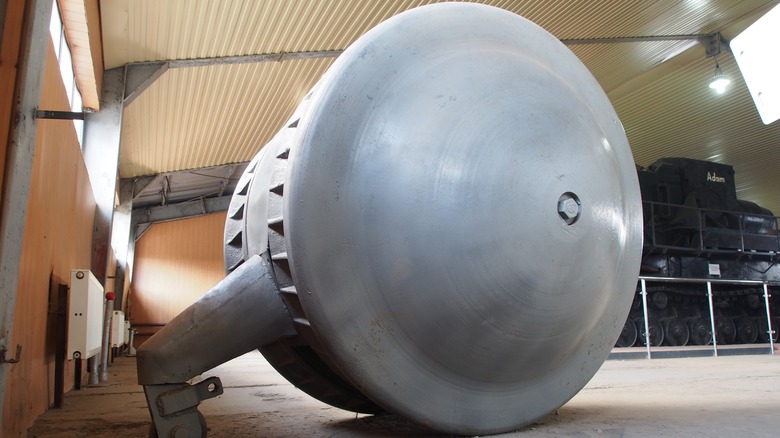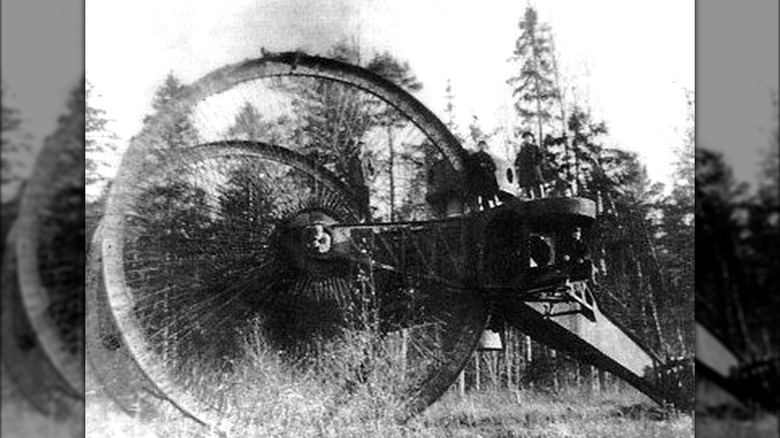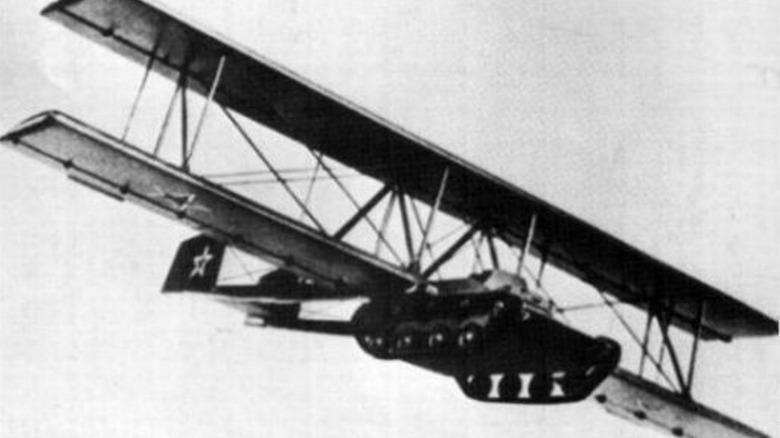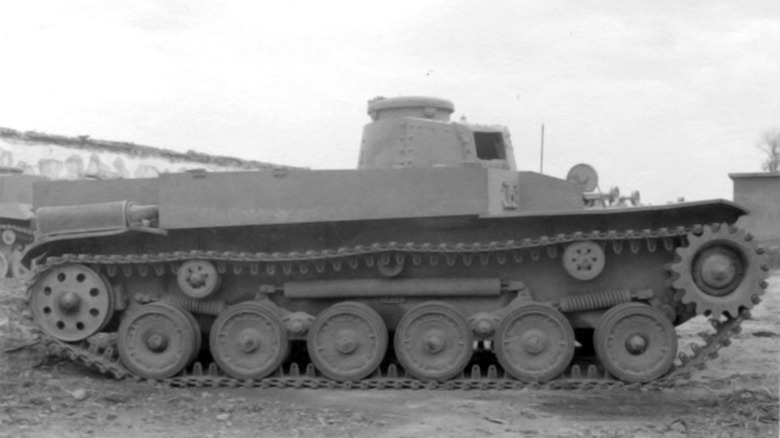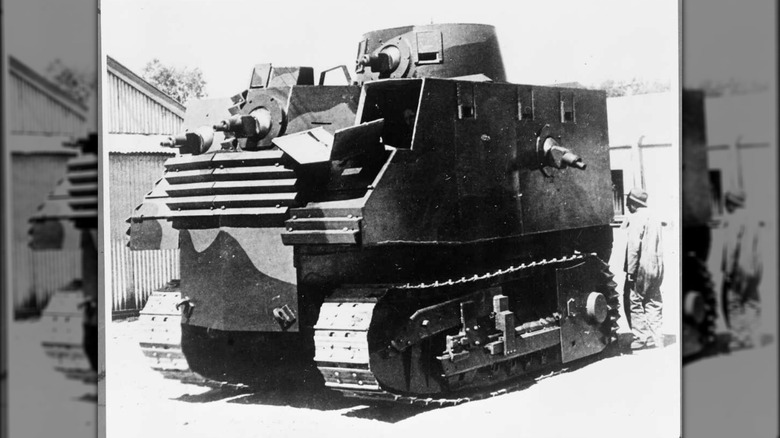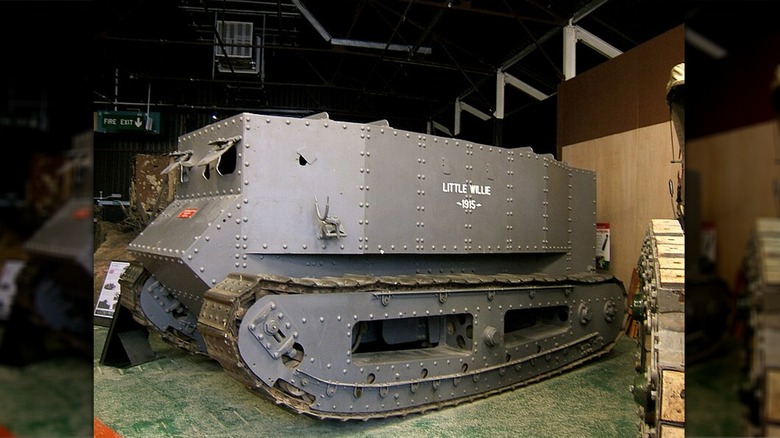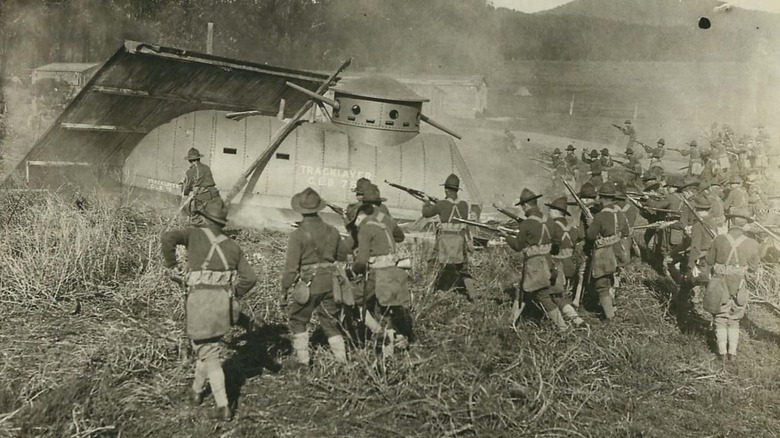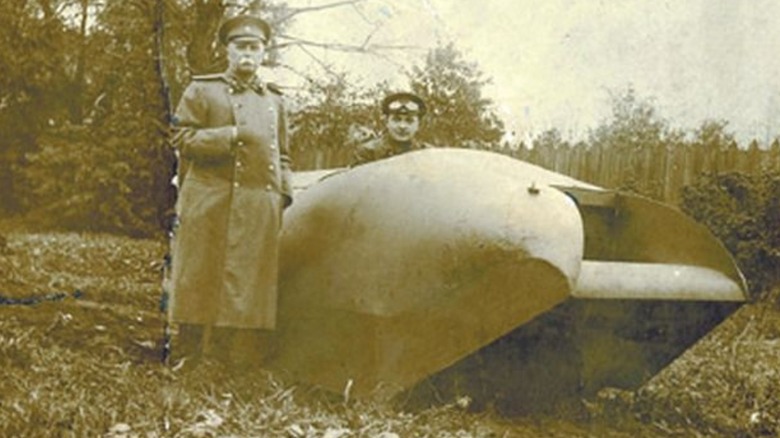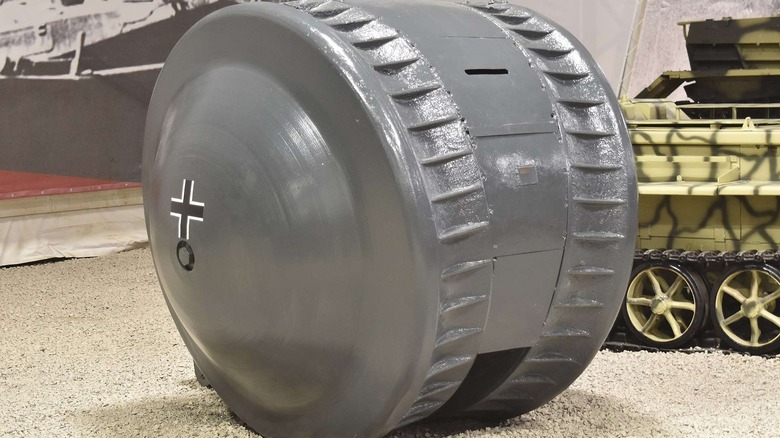8 Strange Tank Prototypes That Never Made It To Battle
Tanks are probably the most recognizable weapons of war. Nowadays, when people hear the word "tank," they think someone is talking about a wide and flat heavy weapons platform propelled by caterpillar treads and topped with a powerful rotating cannon. Not only does this imagery provide a sense of power, but tanks also boast thick, heavy armor that is resistant to small-arms fire. Regardless of these notions of strength and invulnerability, military tanks still come in a variety of shapes and sizes that let them excel in different combat roles. Of course, as with every other invention, you've got to experiment first before you can roll out the final product.
Throughout the history of modern warfare, army engineers have developed test builds of tanks. While some eventually turned into iconic armored vehicles such as the M1 Abrams, others never made it past the prototype phase. You might have heard of the British TOG2 and the German Panzer VIII Maus super tanks that would have tipped the scales at several hundred tons each, but what about Object 279, a Russian heavy tank with four treads instead of the standard two? How about the Swedish UDES XX-20, an "articulated" tank with a separated front and back half? Probably not.
However, these are only a few samples of the failed ideas army engineers have come up with. Quite frankly, you could create a museum dedicated to all the tank prototypes that never made the cut, but for now, here are eight tank designs that were only good on paper.
Lebedenko Tank
If it weren't for World War I, we may not even have tanks. Originally, tanks were created as a means to safely ferry soldiers across the no man's lands of trench warfare, as well as cross or climb trenches when necessary. This is why early tanks were wide, long, and flat with rhomboid-shaped caterpillar tracks as tall as the tank itself. Many tanks followed this blueprint, and those that didn't demonstrated why this design was so effective.
The Lebedenko Tank, better known as the Tsar Tank, was developed in 1915 by Russian engineers Nikolai Lebedenko and Alexander Mikulin. Instead of two caterpillar tracks, the Tsar Tank consisted of two large wheels 27 feet in diameter at the front and a smaller five-foot wheel at the back. The front wheels were intended for mobility, while the rear wheel was meant for stability. As a result, this vehicle looked like a cross between a reverse tricycle and an old penny-farthing bicycle. The Tsar Tank also fielded three cannons -– one up top and one on each front wheel's sponsons –- and a smaller weapons platform on its belly.
With these massive wheels, one might assume the Tsar Tank could roll over any obstacle on a World War I battlefield, and indeed, those front wheels trampled almost everything underfoot. It was the rear wheel that posed a problem. Much of the tank's weight centered on this wheel, which sunk into ditches and soft ground and proved impossible to free. As a result, the Tsar Tank was scrapped, both figuratively and literally, so its thick armor could be used for more viable tank designs.
Antonov A-40
Nations have been experimenting with aerial tank deployment methods ever since the late 1930s. Soviet Air Force engineer Oleg Antonov dreamt up arguably the most novel idea: Attach glider wings to a tank, strap the result to a plane, and release them into the air. Once the tank safely glided to the battlefield, it would shed its wings. To achieve this, Antonov designed a detachable biplane wing cradle with a wingspan of 59 feet, and he chose the T-60 tankette to demonstrate the glider's viability. Antonov also lightened the load by removing the T-60's weapons, ammo, headlights, and most of its fuel, resulting in what was dubbed the Antonov A-40.
Depending on who you ask, the Antonov A-40 either figuratively or literally failed to get off the ground. According to Russian sources, while the A-40 was successfully lifted into the air, the project was abandoned because even with the tank's reduced weight, it was too heavy and caused too much drag for the plane to reliably carry. These problems raised concerns about what would happen if a fully-armed tank were ever strapped to the glider. According to Western sources, however, the Antonov A-40 never made it into the air. Regardless of the truth, the Antonov A-40 ended in failure.
Type 97 Experimental Flamethrower Tank
"Warhammer 40K" is a popular tabletop miniature wargame because many models are moddable. Players can swap parts to give units different details and weapons. For instance, many factions field tanks that can have their cannons, machine guns, and other standard weaponry replaced with miniguns and flamethrowers. That sounds like an outlandish idea until you realize many real-world nations tried something similar, including Japan.
From the late 1930s to the early 1940s, many Japanese soldiers operated the Type 97 Chi-Ha. This medium tank was no slouch, but they rarely survived clashes with Russian tanks. Throughout the Chi-Ha's life, Japan also used the tank as a test bed for numerous experiments, such as the Type 97 Chi-Yu, which used revolving chain flails to clear minefields. However, the weirdest experiment was known as the Type 97 Experimental flamethrower tank.
As its name suggests, this tank sported flamethrowers instead of standard tank armaments which were replaced by equally experimental electric igniting flamethrowers. Very little documentation exists for this flamethrower tank, so nobody knows why the Japanese started experimenting with this vehicle or why they stopped. All we know for sure is that it sported two flamethrowers instead of one, making it the only tank in existence to ever utilize this design.
During World War 2, several countries including the Germans, the United States, and Great Britain attached flamethrowers to tanks in order to assault enemy bunkers, but these fire-spewing variants were short-lived. Perhaps the Type 97 Experimental Flamethrower tank was supposed to fill the same battlefield role but likewise shared the same fate.
Bob Semple Tank
In the "Warhammer 40K" setting, the Orks are one of the most popular armies, partially due to their aesthetic and lore. All Ork vehicles have a slapdash look to them because, in universe, they weld together as many wheels, armor plates, and guns as they can find. No blueprints, no plan aside from making something cool and destructive. The Bob Semple Tank is perhaps the closest anyone has ever come to making real-life Ork vehicles.
During the early days of World War II, New Zealanders lived in constant fear of invasion from Japan. Since neither Great Britain nor Australia could send any supplies, New Zealand's Minister for Public Works, Bob Semple, came up with the best idea he could — build tanks with the materials New Zealanders had on hand. In this case, these consisted of corrugated manganese plates, Caterpillar D8 tractors, and Bren light machine guns. To save time, New Zealand engineers didn't even wait for blueprints. Instead, they began work on these makeshift machines without formal plans.
To call the resulting prototypes, dubbed Bob Semple Tanks, a disappointment would be an understatement. The tractor bases were never meant for the extra weight or firepower, so the vehicles only achieved a max speed of 5 to 6 mph, whereas M4 Sherman Tanks achieved 24 to 29 mph. Moreover, Bob Semple Tanks rolled dangerously whenever they were off-road. It didn't help that these tanks looked like corrugated houses on wheels. These prototypes were the subject of much ridicule, which spread to Bob Semple since he technically invented them.
While Bob Semple Tanks never saw combat, it was better for New Zealand to have them and not need them than to need them and not have them.
Little Willie
Since tanks were originally invented as a means to cross no man's land during World War 1, offense wasn't even originally on engineers' minds. In fact, nobody even called them tanks back then, as they were called landships. According to historians, the first tank designed was called Little Willie, in a not-so-subtle jab at the German Crown Prince Wilhelm.
Since the Little Willie was the first tank ever, its design process resulted in numerous dead ends. Work began in 1915 after Winston Churchill, then Lord of the Admiralty, founded the Landships Committee. However, the organization didn't see any progress until it contracted the agricultural firm William Foster & Co. The result, Little Willie, was drawn up by William Tritton and Walter Wilson, weighed around 14 tons, and looked a lot like a big metal coffin on treads. Furthermore, it got stuck in trenches, achieved a top speed of about three mph, and overheated constantly. Still, Little Willie served its purpose as a test run.
By the time Little Willie was built and not impressing audiences, Tritton and Wilson had already designed an improved successor, which was called Big Willie. This follow-up was longer and more rhomboid in shape, but it actually crossed and climbed up trenches. The Big Willie design was adapted into Britain's first functional tank, or as they called it, His Majesty's Landship, Tank Mk I.
Ironically, while the name "tank" is now synonymous with armored warfare, the vehicle was initially called a tank as an information smokescreen. To deceive their enemies, British officers told workers that the Willies would ferry water across the battlefield as mobile water tanks. Funny how terminology changes over time.
[Image by Andrew Skudder via Wikimedia Commons | Cropped and scaled | CC BY-SA 2.0]
CLB 75
In order to produce early tanks, many militaries contracted experts in the field of caterpillar tracks: farm tractor engineers. As a result, some tank prototypes were little more than armored tractors with cannons mounted on top. In several cases, the prototypes were far from battle-ready, but in one case, the "tank" was just a stage prop.
The Tracklayer Best 75, better known as the CLB 75, was one of the United States' first tanks. Designed by the tractor manufacturer C.L. Best in 1917, the CLB 75 looked less like a tank and more like an overturned boat with a turret up top that housed two cannons and machine guns. Like other American tanks of its time, the CLB 75 was designed without any understanding of the conditions British tanks had to overcome, so its main chassis was just one of Best's tricycle-like autotractors. If you think that design would fare poorly in trench warfare, well, it was never intended for any.
Unlike most tank prototypes, the CLB 75, while somewhat functional, was nothing more than a promotional tool used for films, parades, and military training. A good thing too, since according to reports, the CLB 75 weighed anywhere between 14 and 15 tons. Given the vehicle's main chassis already weighed around 14 tons, whatever material covered the CLB 75 and gave it its unique shape was just for show. The same goes for the "cannons" and "machine guns," which were nothing more than wooden props.
The CLB 75's only contribution to the war effort was that it attracted new recruits and reassured people that American combatants would go into battle with armored support. Thankfully, U.S. soldiers received aid from tanks far more battle-worthy than the CLB 75.
Vezdekhod
All modern tanks, regardless of size, are too big to be manned by one person. Many tanks, including the M1 Abrams, require crews of around four people. One person drives, another mans the guns, a third keeps ammo loaded, and the final crewmember relays orders to the other three. The first Russian tank, however, was designed for a much smaller team.
The Vezdekhod was invented in 1915 by aircraft engineer Aleksandr Porokhovschikov, although some sources claim he drafted the design in 1914. The Vezdekhod was small, barely big enough for two people, and it moved using a combination of a single, wide caterpillar track and two side wheels. Due to its simple design, the tank looked not unlike a metal slug.
Porokhovschikov sold his design on its ability to go anywhere, essentially making the Vezdekhod the predecessor of both modern tanks and ATVs, as its side wheels were supposed to help steer the vehicle. However, testing showed that the wheels could only travel in a straight line. This simple oversight doomed the project, and Porokhovschikov never lived this failure down.
After Russian newspapers circulated stories about British tanks, he declared that he was the father of tanks in general and tried to propose a Vezdekhod-2 design, this time with wheels and a turret with multiple machine guns. While Porokhovschikov designed airplanes until he was accused of espionage and executed several decades later, he never made another tank again.
Kugelpanzer
In 1936, Texan inventor A.J. Richardson designed a new form of tank: the Tumbleweed Tank. The vehicle was shaped like a ball with two rotating halves on the outside and machine guns poking out in several directions. The idea was rejected for several reasons, most notably that crews wouldn't be able to see what was going on outside — soldiers inside would literally shoot blindly. Who could have guessed Germans would come up with a similar design?
The Kugelpanzer is arguably one of the most mysterious vehicles ever devised. The name roughly translates into "ball tank," and the entire platform looks like a metal yo-yo. It is believed the Kugelpanzer's two hemispheres on its sides would propel the tank forward, while the lone wheel in the rear would provide stability, sort of like a compact Tsar Tank. Moreover, the Kugelpanzer only sported a small slit for visibility. As far as armaments went, the Kugelpanzer probably could have utilized a small machine gun, but that's it.
To add to the Kugelpanzer's air of mystery, nobody knows what battlefield role it was supposed to fill. The vehicle's armor could have protected drivers from infantry firearms, but its lack of armaments would have limited its destructive power. To make matters worse, reports regarding the Kugelpanzer's acquisition contradict one another. Some claim the tank was captured in the Kummersdorf proving ground -– the same location where soldiers found the Panzer VIII Maus prototype –- while others state the Kugelpanzer was recovered from Manchuria.
The running theory is that the Kugelpanzer was designed for recon, but without any hard evidence, that's as close as anyone will get to the truth. If it weren't for the name, nobody would even know it was a tank.
[Image by Alan Wilson via Wikimedia Commons | Cropped and scaled | CC BY-SA 2.0]
